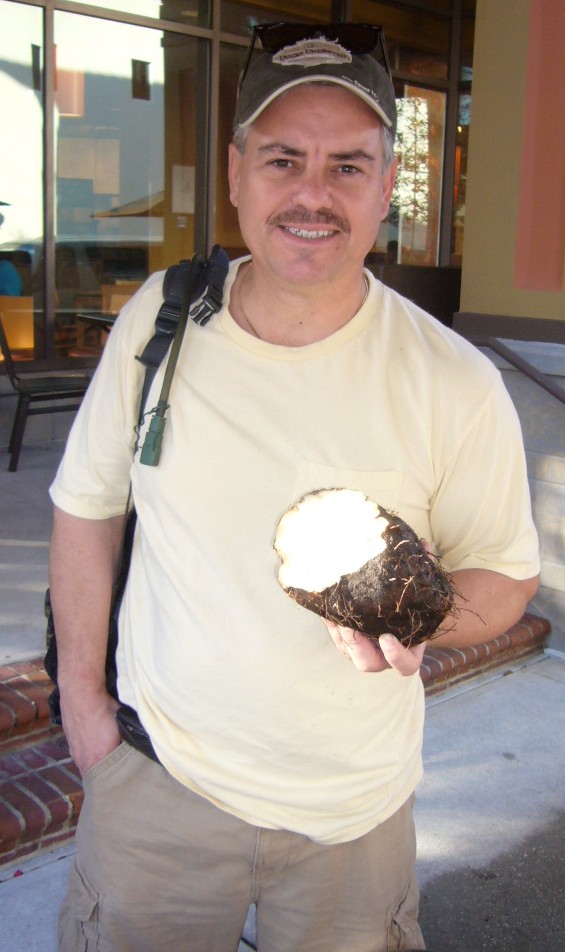
Dan Dowling with a prime example of an Alata root. They break easily when being dug up. Photo by Green Deane
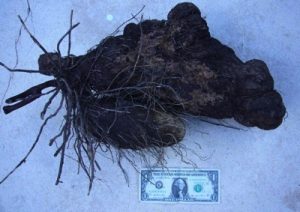
The root of the winged yam. Photo by Green Deane
Yams can be confusing. Regionally there are almost a dozen yams you can find in the wild. Eight do not produce “air” potatoes or put on starch-sequestering roots. So we are not interested in them. That leaves two (not counting deliberately cultivated species.) The winged yam and the bulbifera (bulbifera means bulb producing.) Their seasons don’t coincide. The bulbifera dies back first in the fall, about November, the Winged yam dies back in December or January depending up how much cold weather there is. The bulbifera if first to pop up in the spring, usually March or April. The winged yam is second in late April or May. Over the season both make non-edible air potatoes but only the winged yam locally produces a huge edible root. The bulbifera usually doesn’t (although in Australia it does.) Winged yam shoots are now about a yard long and can be used to find the tasty root. The thicker the vine now the larger the root. The top of the root will feel like a tent stake in the soil. Thin vines will be from last year’s “air potatoes” which is how the species reproduces vegetatively.
With the help of Chef Steve we dug one up during our Port Chartlotte foraging class last Sunday. One boils the root then uses it like a potato (of which it has a similar nutritional profile.) If you can identify this plant — the winged yam — you won’t starve.

Texas Ebony seed pods
It is true you can walk past a useful plant many times and not notice it. That was my experience with the Eastern Red Bud, and perhaps this weekend with the Texas Ebony. One tree of it was identified by a friend’s aunt, so it was added to the edibles’ list. This past week in Dreher park West Palm Beach it was pointed out to me a couple of huge trees also looked like Texas Ebony (this was the first time I recall those two fruiting.) Texas Ebony is is Ebenopsis ebano which means ” spectacular Black ebony” which is better than its last name Pithecellobium flexicaule which is Monkey’s Earring with Bent Stem. What ever it is called it is edible. The seeds of E. ebano are about 35% protein which is comparable to legumes though they are larger than chickpeas. Carbohydrates in 100 grams (before processing) are 29.36 grams, fat 28.16 grams but fiber quite low, 0.51 grams per 100 grams. That’s all about 500 calories. Cooking increases the available protein by some 12% and reduces anti-nutrient phytate 35% and protein inhibitors 96% overall increasing the nutrition. The most common amino acids are leucine, lysine, valine, isoleucine and treosine.

The fungus gall of Gymnosporangium clavipes on a hawthorne
Most foragers would look at this picture (right) and say that is a gall. beginners might think it’s a strange fruit . Plant galls are defined as abnormal plant growths caused by a gall-maker; the gall-maker being certain insects, mites, fungi, and bacteria. Locally Persea Borbornia usually has a lot galls — one of the identifying characteristics — and one particular scrub oak gets galls that look like cranberries.
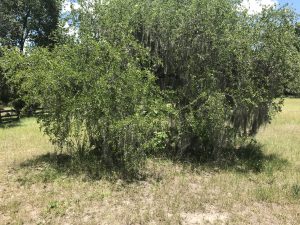
Hawthorn in Lithia Florida, usually not seen south of Ocala.
This is a gall on a Hawthorn fruit and is a fungus, Gymnosporangium clavipes, which is responsible for the disease known as Cedar-Quince Rust. The “cedar” in the relationship is actually the eastern red cedar, which is really a juniper, Juniperous virginana. This fungus must alternate between junipers and a member of the rose family, such as quince, hawthorn, crabapple, etc., to complete its life cycle. It spends a year on plant in the two groups then a year on the other plant.
Hawthorns are an unusual group of trees and can live to 400 yeras old. No one really knows how many species there are, two hundred or 1,200. It is safe to say they vary a lot so identifying which one you have can be quite frustrating. The fruit is edible but not the seeds, and the fruit and leaves dried as a tea can be used for high blood pressure. Herbalists say two teaspoons of leaves or seedless berries (or both) made into a tea twice a day is an effective beta blocker and lowers blood pressure.
Ascross the dirt road I grew up on was a huge hawthorn with two-inch thorns. Different species of birds would nest in the tree at the same time, because the thorns dissuaded egg and chick predator. Unncecessary tarring and widening of the road eliminated the tree.

Range of the one-seeded Hawthorn
Historically hawthorns have been used to make hedgerows and “haw” means hedge. The fruit is a source of pectin, which is protective against DNA damage from gamma radiation besides making jelly. In fact one hawthorn, Crataegus monogyna, the one-seed Hawthorn can be made into a no-cook jelly which can then be dried. Put the berries in a bowl and quickly crush them thoroughly with your hands. The resulting liquid should be about the consistency of pudding just before it sets. It should be that consistency naturally. If you’ve had a dry year add some water to get to that consistency. Work quickly. Squeeze the seeds out of the berries then quickly filter the thick slurry into a bowl. In about five minutes the liquid will jell. Flip it over onto a plate. It can be eaten as is or sliced or sun dried. It will be sweet and will last for many years. Remember just ripe berries have more pectin that over-ripe berries. To see a Ray Mears’ video on this go here.
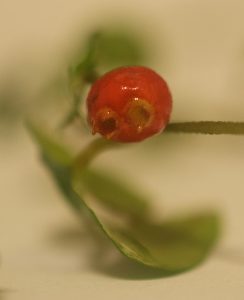
Partridgeberry has two dimples where twin blossoms were. Photo by Green Deane
It is the season time for partridgeberries. While they can be found locally they are more a cooler climate species. I used to find them occasionally in Gainesville Fl but saw them often in August in western North Carolina. Botanically Michlla repens, the species has been used for food and as a diureticc and for the pain associalted with menstrual cramps and child birth. M. repens is a vine that does not climb. It does make an excellent ground cover. The berry is favored by the ruffed grouse hence the name Partridgeberry.
Foraging Classes: Spending my class time on the east coast this weekend. Mebourne and Port Orange.
May 27th , Wickham Park: 2500 Parkway Drive, Melbourne, FL 9 a.m. Meet at the “dog park” inside the park (turn right after entrance.) 9 a.m.
May 28th, Spruce Creek Park, 6250 Ridgewood Ave. Port Orange, 9 a.m.,meet at the pavilion.
June 3rd, Eagle Lake, 1800 Keene Road, Largo, FL 33771. Meet at the pavilion near the dog park, 9 a.m.
June 4th, Mead Gaden, 1500 S. Denning Dr., Winter Park, FL 32789. Meet at the bathrooms. 9 a.m.
Bring cash on the day of class or click here to pay for your class
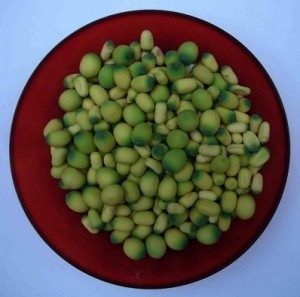
After cooking slice the seeds, remove the small bitter plant inside, eat the rest. Photo by Green Deane
Yellow ponds, that’s how I think of it, or in some places, yellow rivers. That’s because the American Lotus will soon be in blossom. The first time I saw a small lake of these blossoms was when an old dry lake was deepened for a housing development. The next spring suddenly what was for decades a dry lake was full of American Lotus blossoms. This is because the seeds can stay viable some 400 years, or so the experts report. Talk about a survival food! There are multiple edible parts on the American Lotus but I prefer the seeds. I also think when collecting by hand the seeds proved to be the most calories for the amount of work. The roots are edible but digging them up can be a messy, laborious job. Locally American Lotus are easy to find: Just look for a lake with large yellow blossoms on long stems. Further north and west they are a favorite sight on rivers such as the Mississippi. To read more about the American Lotus go here.

You get the USB, not the key.
My nine-DVD set of 135 videos has been phased out and replaced by 171-videos on a 128-GB USB, see right. The USB videos are the same videos I have on You Tube. Some people like to have their own copy especially if social order falters. The USB videos have to be copied to your computer to play. If you want to order the USB go to the DVD/USB order button on the top right of this page or click here. That will take you to an order form. Or you can make a $99 donation, which tells me it is for the USB (include a snail-mail address.) I’d like to thank all of you who ordered the DVD set over the years which required me to burn over 5,000 DVDs individually. I had to stop making them as few programs now will read the ISO files to copy them. Burning a set also took about three hours.

Green Deane Forum
Want to identify a plant? Perhaps you’re looking for a foraging reference? You might have a UFO, an Unidentified Flowering Object, you want identified. On the Green Deane Forum we — including Green Deane and others from around the world — chat about foraging all year. And it’s not just about warm-weather plants or just North American flora. Many nations share common weeds so there’s a lot to talk about. There’s also more than weeds. The reference section has information for foraging around the world. There are also articles on food preservation, and forgotten skills from making bows to fermenting food. Recent topics include: Stale Bread and Cod Liver Oil, Killing Bugs with Tobacco Plugs, Eating weeds: Is it safe? Have they mutated? Not the Eastern Red Bug but the Pink Tabebuia, African Tulip Tree, Asparagus densiflorus, Green Deane’s Book… You can join the forum by clicking on the button on the upper right hand side of this page.
This is my weekly newsletter #559. If you want to subscribe to this free newsletter you can find the sign-up form in the menu at the top of the page. My website, EatTheWeeds.com, which is data secure, has over 1500 plants on it in some 428 articles. I wrote every one myself, no cut and paste.
To donate to the Green Deane Newsletter click here.

